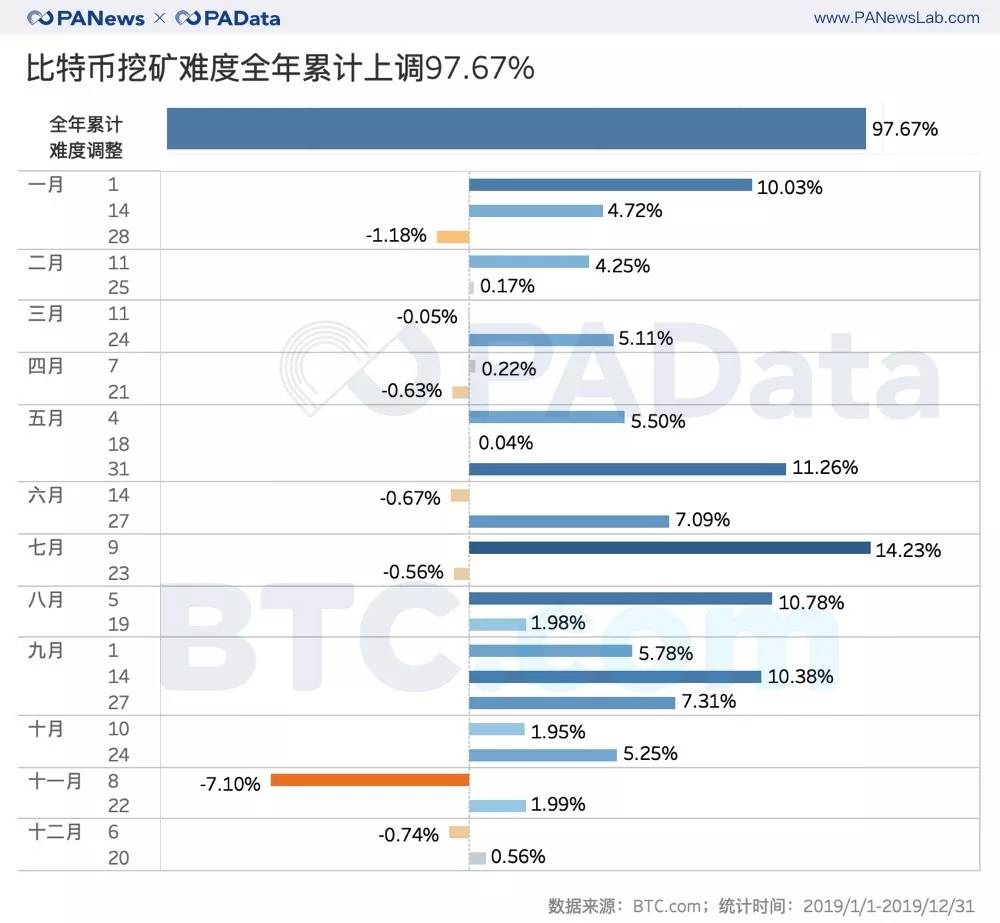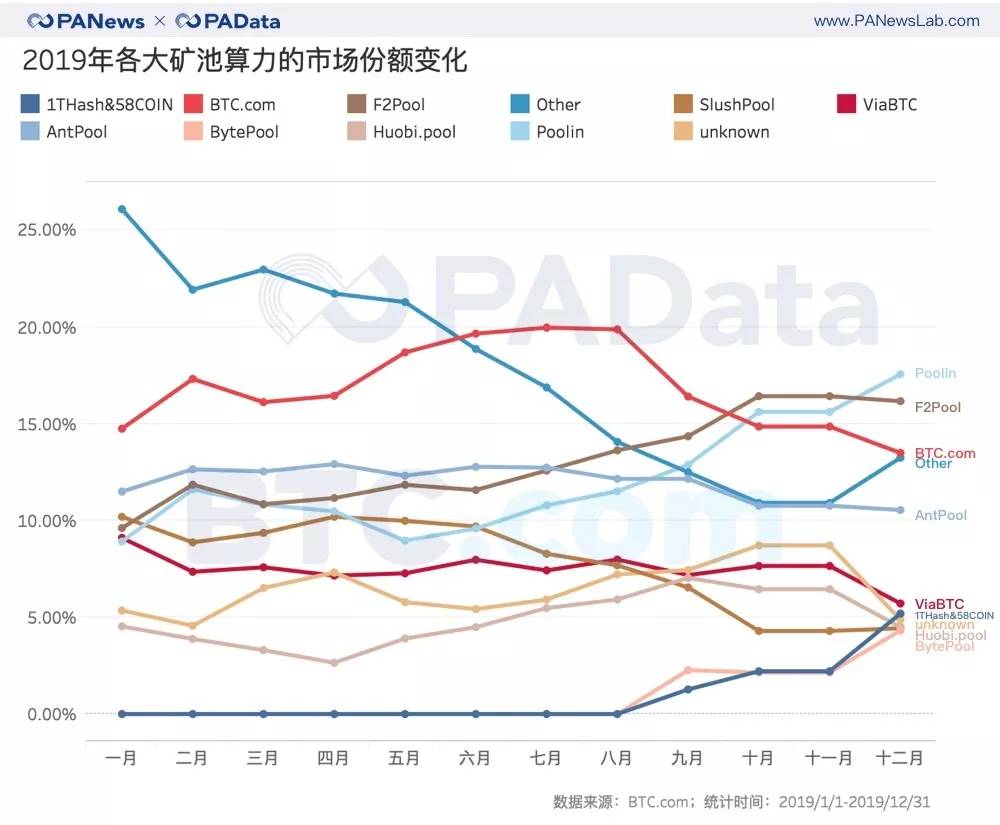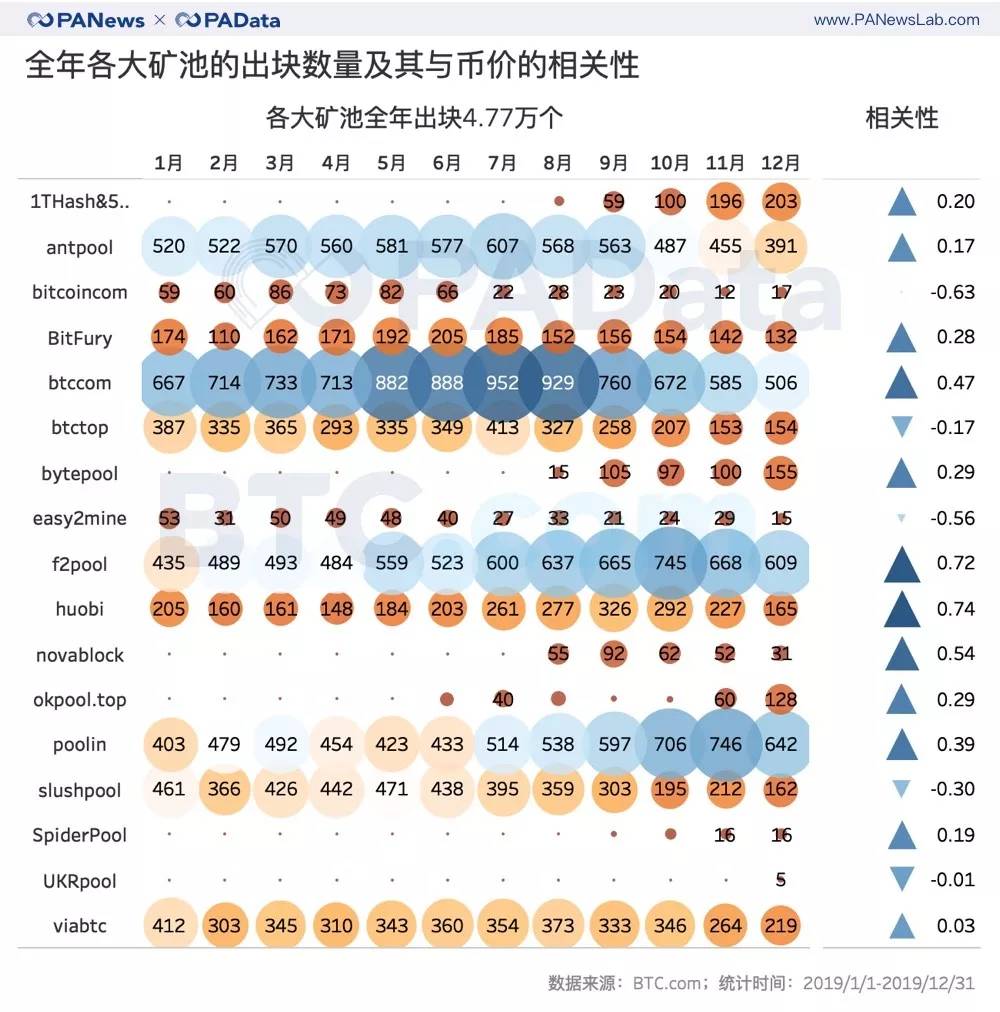Counting mining 2019 | Difficulty of mining increased by 97.67% throughout the year. Which mining pool is on the right pace?

Text, Data and Visualization | Carol Editing | Bi Tongtong
Data Partners | By BTC.com | PANews
The mining circle is a mysterious and closed circle for many people. Earlier, PANews and Tencent News jointly produced "Miner Besieged City" telling the rumbling sound of the mines that screamed through the day and night. Under the bitcoin "roller coaster" market, miners, mine owners, miners, and "inverted masters" interpreted the mines. Circle "Lake". If these real stories are just a microcosm of the mining circle, then the data can restore the true appearance of the mining circle in 2019. Did you make money in the mining circle in 2019? How will this mysterious niche industry develop in the future? This article is "Review of Bitcoin mining data in 2019 (1)"
- Cryptocurrency fights for freedom in India's Supreme Court, but opponents see too much risk
- Analysis | The logic behind USDT's continued negative premium
- Dry goods | Full homomorphic encryption resource summary
PAData Insights:
- In 2019, Bitcoin's entire network computing power rose by 143.59%, with the highest increase reaching 202.71%. Among them, June had the highest monthly increase in computing power in a single month.
- In 2019, the bitcoin network raised the difficulty 20 times throughout the year, reduced it 7 times, and increased the difficulty 97.67%.
- In 2019, except for the second quarter, the profitability of miners is not optimistic.
- For the year's computing power share, BTC.com, F2Pool, and Poolin ranked in the top three in turn. At the end of the year, Poolin and F2Pool “counter-attacked” BTC.com, placing them in the top two spots.
- F2Pool and Huobi.pool have a high correlation between the number of blocks produced each month and the average monthly coin price. That is, when the currency price is high, the number of blocks produced by the two is also large, and they have stepped on the rhythm throughout the year.

1.Computing power increased by 143.59% for the whole year.
In 2019, the computing power of Bitcoin's entire network showed a clear upward trend. The annual increase in computing power reached 143.59%, with the highest increase reaching 202.71% . As of December 31, the computing power of the entire network reached 98.77 EH / s. Judging from the growth trend of monthly computing power, in May and June when the currency price is in a rapid rise period, and in September when the currency price is in a shock adjustment period, the year's computing power is growing rapidly. Among them, the computing power of the entire network rose by 22.29% in June, which was the highest monthly increase in computing power in a single month.

Due to the lag in market regulation, the rapid increase in computing power in June may be the result of the gradual entry of miners after seeing a clear rising signal at the end of April. The cause of this lag is related to the sudden adjustment of the production capacity of the miner manufacturer by the bear market and the time it takes for miners to purchase the miner, arrange the miner, and run the miner. Similarly, when the price of the currency starts to fluctuate or fall, the computing power will not drop immediately, and there will be a certain lag time. In September, the price of the currency entered a fluctuating downtrend channel, but the computing power still showed a clear upward trend, but in October and November thereafter, the computing power no longer continued to rise. This is mainly because there is a certain time difference between the miners watching the currency price trend and adjusting the mining behavior.
Based on the theory of excess profit, PAData analyzes the increase in computing power and the price of currency. It believes that in the past ten years, the Bitcoin mining industry has shown a cyclical pattern of three years, with a main profit period of about one year and about two years. Composition of the adjustment period. The mining industry in 2019 is still in the adjustment period in the three-year cycle. The main profit period refers to the period during which mining power can obtain excess profits because the growth rate of computing power is less than the growth rate of currency prices over a period of time. Otherwise, the decline in mining profits belongs to the adjustment period. The latest round of adjustment period began in January 2018. In 2019, the mining industry is still in the deep adjustment period. The annual currency price increased by 88.21%, and the computing power increased by 143.59%.
However, due to the continued rise of the currency price in the second quarter, the increase exceeded the increase in computing power over the same period (the slope of the orange function in the figure below> the slope of the blue function), and the mining industry ushered in a short profit period. However, since the third quarter and the fourth quarter, the currency price has fallen, but the computing power has continued to increase moderately, and mining profitability pressure has increased.

If the time dimension is folded to each quarter, the comparison of the trend of computing power and currency price is more obvious. In 2019, except for the second quarter, the profitability of miners is not optimistic.

The Bitcoin network will adjust the mining difficulty according to the computing power. This is a constraint mechanism to maintain the relative stability of the system. According to BTC.com statistics, in 2019, the Bitcoin network has raised the difficulty 20 times in total, reduced the difficulty 7 times, and cumulatively increased the difficulty 97.67%.

Among them, on July 9th, the online difficulty adjustment was 14.23%, which was the most difficult for a single increase throughout the year. In addition, in January, May, August, and September, there was a single increase of more than 10%. Compared to the upward adjustment, the difficulty reduction appears to be much milder. In the whole year, the difficulty level was reduced by 7.10% only on November 8th. The remaining six reductions were around 1%. In the mining cycle, the rise in the price of currency—the increase in computing power—and the difficulty increase have formed a causal chain reaction with a lag.
The price of the currency is "unclear" and the difficulty continues to rise, and the business of the mining circle is increasingly testing its brain power. The mine owner Wen Ge (a pseudonym) who has operated the mine for several years said in an interview with PANews that "the threshold for bitcoin mining is getting higher and higher. In the past, you can" brainless "mining. Now you have to hedge to stabilize. Yield. Otherwise, if the market collapses one day and the machine cannot be shut down because of the agreement, the mine will have to bear a lot of losses. "
2.BTC.com gives way to the largest mining pool
The large mining pool has gathered more computing power in the market and has a natural advantage in producing blocks. Looking at the market share of computing power for the whole year, BTC.com occupies 17.16% of Bitcoin's entire network. F2Pool and Poolin are ranked second and third, respectively, accounting for 12.21% and 11.98% of the entire network. The three mining pools constitute the first camp of computing power.
Second, AntPool, SlushPool, ViaBTC, and BTC.TOP accounted for more than 5% of the annual average computing power. These four mining pools constitute the second camp of the Bitcoin computing power market.

However, unlike the stable situation of "three-legged standing" of Binance, Huobi, and OKEx in the exchange circuit, the competition in the mining pool is more intense.
In 2019, the hashrate market share has changed frequently. According to statistics, before August 2019, BTC.com always dominated the computing power market, but after August, its computing power market share began to decline, and as of the end of the year, it has fallen to third place. Ranking does not include Other), its computing power in December fell to 13.49% of the entire network computing power. There is also AntPool, a large mining pool that has gone downhill. At the beginning of the year, it occupied the second place with 11.49% of the computing power of the entire network. However, by the end of the year, its computing power market share has fallen to fourth place. The computing power share in December was about At 10.54%, the share of computing power for the whole year decreased by 8.27%.

On the other hand, both Poolin and F2Pool have completed a "counter attack" in 2019. Poolin's computing power at the beginning of the year only accounted for 8.91% of the entire network, ranking sixth among the major mining pools. Even before May, Poolin's hashrate market share had declined, but after May, its hashrate market share has increased rapidly. As of December, Poolin has become the largest mining pool in the entire network. Its computing power market share has reached 17.55%, and the annual computing power share increase is about 96.97%.
The trajectory of F2Pool's computing power is similar to that of Poolin. At the beginning of the year, its computing power accounted for about 9.61% of the entire network and ranked fourth among the major mining pools. At the end of the year, its computing power accounted for 16.16% of the entire network. , Is the second largest mining pool in the entire network, with an annual increase of computing power of approximately 68.16%.
It is also worth noting that 1THash & 58COIN and BytePool developed strongly at the end of the year. 1THash & 58COIN's hashrate market share reached 5.19% in December, surpassing Huobi.pool and ranked 6th. BytePool also occupied 4.32% of the computing power share of the entire network in December. Although it is not ranked high in large mining pools, its share is not far behind Huobi.pool and 1THash & 58COIN.
In view of the mining cycle under the theory of excess profits, the mining revenue pressure in the third and fourth quarters of 2019 is relatively large, so although 1THash & 58COIN and BytePool occupied a good market share at the end of the year, they did not catch up with the profitable ones. Good time. This shows the second aspect of the fierce competition in the mining industry. Not only does the computing power share of the major mining pools change frequently, but although more players enter the market and want to share a piece of cake, only a small number of mining pools actually eat it. Excess profit.
3.F2Pool and Huobi.pool step up and down in the price of quasi-coin
Which mining pools have stepped on the right pace in 2019 and made excess profits?
PAData counts the number of monthly blocks produced by major mining pools throughout the year and analyzes the correlation between them and the average monthly currency price.
According to statistics, BTC.com, which has the largest average computing power in the whole year, has more than 500 monthly block productions throughout the year, and more than 800 monthly block productions from May to August. However , the Pearson correlation coefficient between BTC.com's monthly block volume and the average monthly currency price is only 0.47, showing a weak correlation. This means that even though BTC.com had an excess profit in the second quarter, it also maintained a steady block production in the first, third and fourth quarters, which had heavy mining revenue pressure. Lowered its annual revenue level.

F2Pool, which has completed the "counterattack" of computing power share this year, is fully on pace. Its number of blocks produced each month after May is more than 500, of which the number of blocks produced in October is the most, reaching 745. F2Pool has a high correlation between the number of blocks produced each month and the average monthly currency price, and the Pearson coefficient has reached 0.72. This basically means that when the currency price is high, the number of blocks produced by F2Pool is also large. However, the most accurate pace is Huobi.pool. The correlation between the monthly block production and the monthly average currency price reached 0.74.
However, Poolin, who also completed the "counter attack" of computing power shares, did not follow the right rhythm. After July, the number of blocks produced was stable at more than 500. However, at that time, the currency price no longer continued to attack, but entered a period of shock adjustment. So, the correlation coefficient between the number of blocks produced by Poolin per month and the monthly average currency price is only 0.39, which is basically irrelevant.
The most "no rhythm" mining pools in 2019 may be Bitcoin.com and easy2mine. The correlation coefficients between the monthly block output and the monthly average currency price of the two mining pools are -0.63 and -0.56, which are equivalent to When the currency price is low, the two mining pools produce a large number of blocks. When the currency price is high, the number of blocks is actually low.
Pay attention to the PANews WeChat public account, the next part tells you, will the mining pool and cloud computing power be rich in 2019?
We will continue to update Blocking; if you have any questions or suggestions, please contact us!
Was this article helpful?
93 out of 132 found this helpful
Related articles
- About the US folk think tank version of the DCB "digital dollar", you need to know these
- The best activity on the Bitcoin chain for two months, even the handling fee has increased by 89%
- Winter night road, there is light at the end-Babbitt's annual inventory and column author's 2020 outlook
- Blockchain is No. 1 and EQ is on the list. What skills are needed to find a job in 2020?
- The former chairman of the CFTC led Accenture to guarantee that the digital dollar will be far behind?
- Blockchain Applications from the Perspective of Legal Persons: Taking the Judicial and Supply Chain Finance Fields as Examples
- Analysis: Is there any real usage scenario for Bitcoin?





